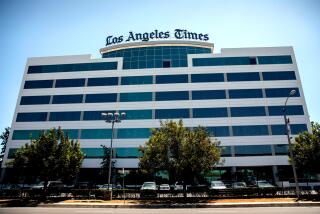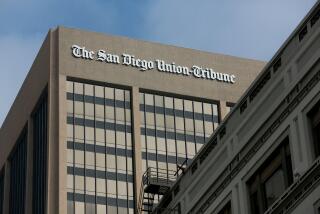N.Y. Times to Buy Boston Globe in $1.1-Billion Deal
- Share via
The owners of the Boston Globe on Thursday agreed to sell the paper to the New York Times for $1.1 billion, sources at the newspapers said, marking the largest sale of an American daily newspaper in history.
The sale, which was formally announced in today’s editions of the two papers, would end family control at one of the last major independent newspapers in the country.
If approved by stockholders, the deal would combine into one company the dominant papers in both Boston and New York and two of the most influential papers in the country and stand as a major investment by the Times in newspapers at a time when many are questioning the long-term vitality of the industry.
The newspaper industry is suffering the fifth year of the worst slump in its history and has prompted many media companies to look again at diversifying away from newspapers into new forms of information delivery and other businesses.
The New York Times, which already relies on newspapers for 70% of its revenues, appears to be significantly increasing its stake in its core business.
In Affiliated Publications Inc., which owns the Globe, the Times will be buying New England’s most powerful newspaper as well as a minority stake in a few magazines, including Billboard and the Hollywood Reporter.
The Times Co., owned mostly by the Sulzberger Ochs family, will buy Affiliated for an exchange of Times stock. But Affiliated shareholders would have the option to receive 15% of their proceeds in cash.
According to sources familiar with the deal, the terms of the sale include assurances that the Globe will be run as an independent identity with management control remaining in the hands of the Taylor family in Boston, though some at the Globe are suspicious of how long those assurances will last.
Sources said the negotiations even included contracts guaranteeing the employment of the Globe’s senior management. At a Thursday afternoon meeting of his senior news staff, Globe editor Matthew Storin said that nothing at the paper would change “for the foreseeable future.”
The foreseeable future, as defined in the sale, is five years.
The sale was being forced on Affiliated by terms of a family trust, which comes due in 1996. Most analysts on Wall Street and at Affiliated, predicted the trust, rather than being renewed, would have resulted in the paper being put up for auction to the highest bidder.
By selling now, three years before, the Taylor family that operates the Globe could pick its suitor.
The mood at the Globe Thursday was resigned but calm in reaction to news that had been rumored for days, though it was not certain until the Affiliated board met and approved the offer Thursday afternoon.
“Being owned by the New York Times is about as good as you can do,” city editor Walter Robinson said, “but being independent is a lot better and we have lost that.”
The sale ends a legacy of family ownership stretching back to 1872.
To keep news of the talks secret, principals in the negotiations used aliases based on river names. The Times was referred to as Hudson. The Globe was Charles.
Under the terms of the sale, the Globe will have three representatives on the Times board and the Times Co. will have 60% of the vote on a new Globe board.
The acquisition of Affiliated would be the largest of an American daily newspaper company, surpassing Gannett Co.’s $717-million acquisition in 1985 of the Evening News Assn., owner of the Detroit News.
The Globe, the nation’s 13th-largest daily and the largest in New England, has a daily circulation of 505,000 and 811,000 on Sunday. The New York Times is the country’s third-largest daily with a circulation of 1.2 million weekdays and the largest Sunday edition with a circulation of 1.8 million.
The deal would put the Times in the top five of media companies in terms of revenues from newspaper holdings, behind Gannett Co., Knight-Ridder Inc., the Tribune Co. and Times Mirror Co., publisher of the Los Angeles Times.
Besides its flagship paper, The New York Times Co. owns 31 daily and weekly newspapers in the South, Maine and California, including the Santa Barbara News Press and the Santa Rosa Press Democrat.
The company also publishes magazines, including Family Circle and Golf Digest, and owns five network-affiliated television stations.
Affiliated owns 33% of a firm that publishes such trade newspapers and magazines as the Hollywood Reporter, AdWeek and Billboard.
According to published reports, the Taylor and Jordan families that owned the Globe had rejected an earlier offer by the New York Times Co. that one industry executive valued at $1.09 billion.
Most Wall Street analysts had considered that figure, which was 2.5 times annual revenues, to be “the highest you would get,” said Ken Berents, an analyst with Wheat First Securities.
One account had a faction of the Taylor family, led by newly appointed Globe President Benjamin B. Taylor, persuading the clan to turn that down in favor of possibly reconstituting trusts or selling a minority stake to ensure independent control.
During the heady 1980s, some newspapers sold for as high as four times revenues.
The new offer included more explicit guarantees of local control, sources familiar with the deal said.
For the New York Times Co., the Globe has several attractions, though none of them overwhelming, and during the week Times stock actually slipped somewhat. New York Times stock on Thursday closed down 62 1/2 cents a share at $26.875 on the American Stock Exchange.
Affiliated closed Thursday down 25 cents at $13.25 on the New York Stock Exchange.
Even if no sale were arranged, the Times Co. was going to announce an agreement soon by which it would begin printing and distributing a New England version of its national edition through the Globe company.
Under the present system, the Times sends its New York metropolitan edition to Boston by truck.
Both companies also have magazine divisions. There are potential efficiencies for selling advertising across the Northeast corridor.
More to the point, said Morton, is that “I think the appeal is the opportunity to achieve a huge amount of revenues and high profitability very quickly” once the New England economy improves.
The Globe is also a quality newspaper with new color printing plants. “The Globe requires no work,” Morton said.
In 1992, the last year for which there are complete figures, Affiliated earned $27.9 million on revenues of $414 million. The New York Times Co. lost $11.3 million on revenues of $1.77 billion.
More to Read
The biggest entertainment stories
Get our big stories about Hollywood, film, television, music, arts, culture and more right in your inbox as soon as they publish.
You may occasionally receive promotional content from the Los Angeles Times.










